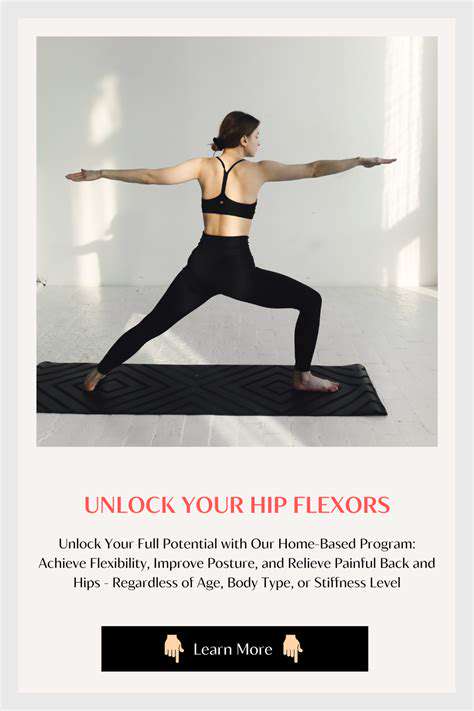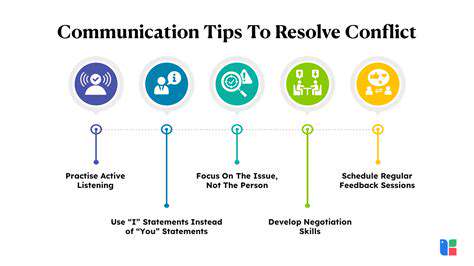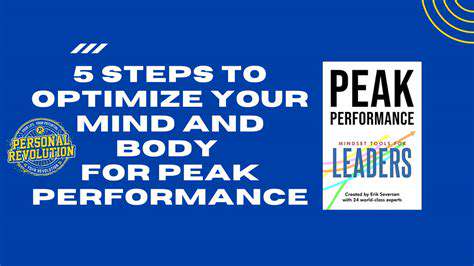How to Increase Your Flexibility Safely and Effectively
Dynamic Stretching for Increased Range of Motion
Dynamic stretching involves moving your joints through a range of motion, gradually increasing the amplitude of movement over time. This type of stretching is ideal for warming up before exercise, as it prepares your muscles and tendons for the demands of activity. It's crucial to maintain a controlled and smooth motion during dynamic stretches, avoiding jerky movements that could lead to injury. Examples include arm circles, leg swings, and torso twists. Proper dynamic stretching enhances blood flow to the muscles, which aids in delivering oxygen and nutrients, further supporting flexibility and performance.
Focus on controlled movements, rather than bouncing or jerking. Start with smaller ranges of motion and gradually increase them as your body warms up. Listen to your body and stop if you feel any pain. Dynamic stretching is a valuable tool for improving flexibility and preparing for physical activity.
Static Stretching for Muscle Lengthening
Static stretching involves holding a stretch for a period of time, typically 15-30 seconds, to lengthen the muscles and increase flexibility. This type of stretching is best performed after a workout or when your muscles are already warmed up. Holding a stretch passively allows the muscle to lengthen gradually, improving its elasticity. Important considerations include maintaining a comfortable and controlled stretch, avoiding bouncing or jerking motions, and holding the stretch for an adequate duration to elicit the desired effect.
Proprioceptive Neuromuscular Facilitation (PNF) Stretching
PNF stretching is a more advanced technique that combines static stretching with contractions of the muscle being stretched. It involves a partner or a resistance band to provide controlled tension. There are various PNF stretching methods, such as hold-relax and contract-relax. These methods are often more effective in increasing flexibility than static stretching alone. PNF stretching can be particularly helpful for individuals with limited flexibility or those looking for a significant increase in their range of motion.
Proper technique is vital with PNF stretching. Always consult with a qualified professional or physical therapist for proper guidance and to avoid injury. The increased intensity of this method demands precision and careful execution to obtain optimal results.
Foam Rolling for Myofascial Release
Foam rolling is a self-myofascial release technique that involves using a foam roller to apply pressure to tight muscles and connective tissues. This technique helps to break down adhesions and knots in the fascia, a thin layer of tissue that surrounds muscles and organs. Regular foam rolling can improve blood flow, reduce muscle tension, and promote flexibility. Foam rolling can be incorporated into a daily routine to target specific areas of tightness and improve overall flexibility.
It's essential to apply appropriate pressure and to avoid rolling over bony prominences or areas of acute pain. Consistency is key for seeing results. Foam rolling can be a valuable tool in conjunction with other stretching techniques for achieving greater flexibility and reducing muscle soreness.
Understanding the Importance of Warm-up and Cool-down
Before any stretching routine, it's crucial to warm up the muscles. This prepares the body for increased flexibility and reduces the risk of injury. Warm-up activities can include light cardio, such as jogging or jumping jacks, or dynamic stretches. A proper cool-down, which involves static stretching, is equally important. It allows the body to gradually return to its resting state, preventing muscle stiffness and soreness. These preparatory and recovery steps are essential components of any stretching program and should never be overlooked.
Proper warm-up and cool-down procedures are fundamental for maximizing the benefits of stretching and minimizing the risk of injury. They should be integrated into every stretching regimen to support the body's natural healing and recovery processes.
Incorporating Flexibility into Your Daily Life

Embracing Adaptability
In today's rapidly changing world, the ability to adapt and embrace flexibility is paramount. This adaptability allows individuals to navigate challenges and seize opportunities with greater ease and effectiveness. Flexibility isn't just about adjusting to external circumstances; it's also about cultivating an internal mindset that allows for change and growth. This includes being open to new ideas and perspectives, and being willing to step outside of your comfort zone.
Prioritizing Self-Care
Incorporating flexibility into your life often hinges on prioritizing your well-being. A crucial element of this is making self-care a non-negotiable part of your routine. This means creating time for activities that rejuvenate and replenish you, whether it's exercise, meditation, spending time in nature, or simply engaging in hobbies you enjoy. Prioritizing your well-being directly contributes to your overall resilience and capacity to handle the demands of a flexible lifestyle.
Setting Realistic Goals
When striving for flexibility, it's essential to set realistic goals. Unrealistic expectations can lead to frustration and feelings of inadequacy. Instead, break down large goals into smaller, manageable steps. This approach allows for a more gradual and sustainable implementation of flexibility into your daily routine. Setting achievable milestones provides a sense of accomplishment and encourages continued progress.
Leveraging Technology
Modern technology offers numerous tools and resources to enhance flexibility. From project management software to communication platforms, these tools can streamline tasks and facilitate collaboration. Learning how to effectively utilize these technological resources can significantly improve productivity and efficiency, especially in a flexible work environment. This allows for greater control over your schedule and work-life integration.
Cultivating Strong Communication Skills
Effective communication is vital for maintaining clarity and collaboration in a flexible environment. This involves actively listening to others, expressing your needs clearly, and maintaining open channels of communication. Strong communication skills are essential for navigating potential conflicts and misunderstandings, fostering trust and mutual respect. These skills are even more critical when working remotely or with colleagues in different time zones.
Building a Supportive Network
Building a strong support network is crucial for navigating the complexities of a flexible lifestyle. Surrounding yourself with individuals who understand and support your goals can provide valuable encouragement and guidance. This network can include mentors, friends, family, or colleagues. A supportive network can help you stay motivated, maintain a positive outlook, and overcome challenges that may arise. This network provides a sense of belonging and community, which is vital for overall well-being.
Cool-down and Recovery: Crucial for Long-Term Gains
Importance of Cool-down
Cooling down after a flexibility training session is not just about feeling good; it's a critical component of achieving long-term gains. A proper cool-down helps gradually return your cardiovascular system to its resting state, preventing blood pooling in the extremities and reducing the risk of muscle soreness and stiffness. This gradual transition allows your body to efficiently transport waste products away from the muscles, promoting recovery and reducing delayed-onset muscle soreness (DOMS). Failing to cool down can hinder your progress and potentially increase your risk of injury.
Active Recovery Techniques
Active recovery involves light physical activity that keeps your blood flowing without putting excessive stress on your muscles. This could include a brisk walk, gentle stretching, or cycling at a low intensity. These activities help maintain circulation, promote muscle relaxation, and reduce the buildup of lactic acid, a byproduct of intense exercise that contributes to muscle fatigue. Active recovery is particularly beneficial for maintaining flexibility and preventing stiffness after rigorous stretching sessions. Incorporating these techniques into your routine can significantly enhance your overall recovery process.
Static Stretching for Muscle Relaxation
Static stretching, holding a stretch for a prolonged period, is an excellent way to improve flexibility and promote muscle relaxation. Focus on holding each stretch for at least 20-30 seconds, allowing your muscles to lengthen and adapt. Targeting major muscle groups like hamstrings, quadriceps, calves, and hip flexors is crucial for maintaining a full range of motion. By consistently performing static stretches, you can significantly improve your flexibility and reduce the risk of muscle imbalances, which can contribute to injury.
Nutrition and Hydration for Optimal Recovery
Proper nutrition and hydration play a pivotal role in the recovery process after flexibility training. Consuming a balanced diet rich in protein, carbohydrates, and essential vitamins and minerals helps repair muscle tissue and replenish energy stores. Sufficient hydration is equally important, as water is crucial for transporting nutrients to muscles and removing waste products. Drinking plenty of water throughout the day, and especially before, during, and after your flexibility exercises, is essential for optimal performance and recovery. A well-nourished and hydrated body is better equipped to handle the demands of flexibility training and achieve long-term gains.
Rest and Sleep for Muscle Repair
Adequate rest and quality sleep are often overlooked but are absolutely essential for muscle repair and recovery after flexibility training. During sleep, your body releases growth hormones that play a vital role in tissue repair and regeneration. Aim for 7-9 hours of quality sleep each night to allow your body to fully recover from the demands of stretching and improve your overall flexibility. Rest periods between workouts also allow your muscles to rejuvenate, preventing overtraining and promoting consistent progress in your flexibility journey. Prioritizing rest is as important as the flexibility exercises themselves.
Read more about How to Increase Your Flexibility Safely and Effectively
Hot Recommendations
-
*Guide to Managing Gout Through Diet
-
*Best Habits for Financial Well being
-
*How to Build a Routine for Better Mental Health
-
*How to Eat Healthy on a Budget [Tips & Meal Ideas]
-
*Guide to Practicing Self Acceptance
-
*How to Incorporate More Movement Into Your Day
-
*Guide to Managing Chronic Pain Naturally
-
*Guide to Building a Reading Habit for Well being
-
*Top 5 Weight Loss Supplements That Actually Work
-
*Best Exercises for Postpartum Recovery [Beyond Abdominal Work]










![How to Make Healthy Eating a Habit [Tips & Tricks]](/static/images/26/2025-07/SustainingYourMomentum3ALong-TermStrategies.jpg)